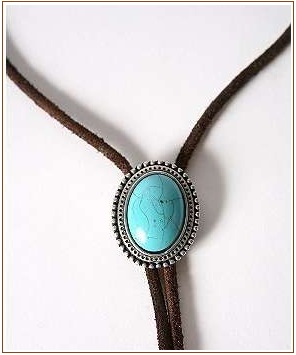Teresa’s mask brooches easily convert to a pendant… they also make great bolo ties.
A version of the bolo tie was already in use by Native Americans well before Arizona resident Victor E. Cedarstaff stumbled upon the idea in 1940.
Indeed, there are several late 19th – early 20th century accounts of Hopi and Navajo tribesmen wearing bandanas or braided leather cords around their necks which were held in place with a conch or other shell.
The Desert Caballeros Western Museum, located in Wickenburg, Arizona, counts several Native American, turquoise bearing bolo ties in its extensive collection. However, it is generally agreed that silversmith Victor E. Cedarstaff formally introduced the device as a personal accessory for men in the 1940’s.
The story goes something like this: While attempting to round-up some wild horses with a group of men, Cedarstaff’s hatband slipped off, taking the hat along with it or perhaps rendering it light enough to easily fly off. Upon retrieving his hatband from the ground, it is said that Cedarstaff slipped it around his neck for the moment so as to not lose it and a colleague pointed out how good it actually looked. This sparked an idea. Cedarstaff braided leather cords and secured the tips with silver tips to prevent them from coming undone. He used a turquoise stone as an adjustable clasp. The logical next step was a patent application, and voilà!
As for the name “bolo tie,” it is said to come from “boleadoras,” a rope with weights attached at both ends, used especially to catch cattle or game by entangling their legs. Bola is the original spelling.
In 2007, the bolo tie was named the official tie of New Mexico and Texas.











